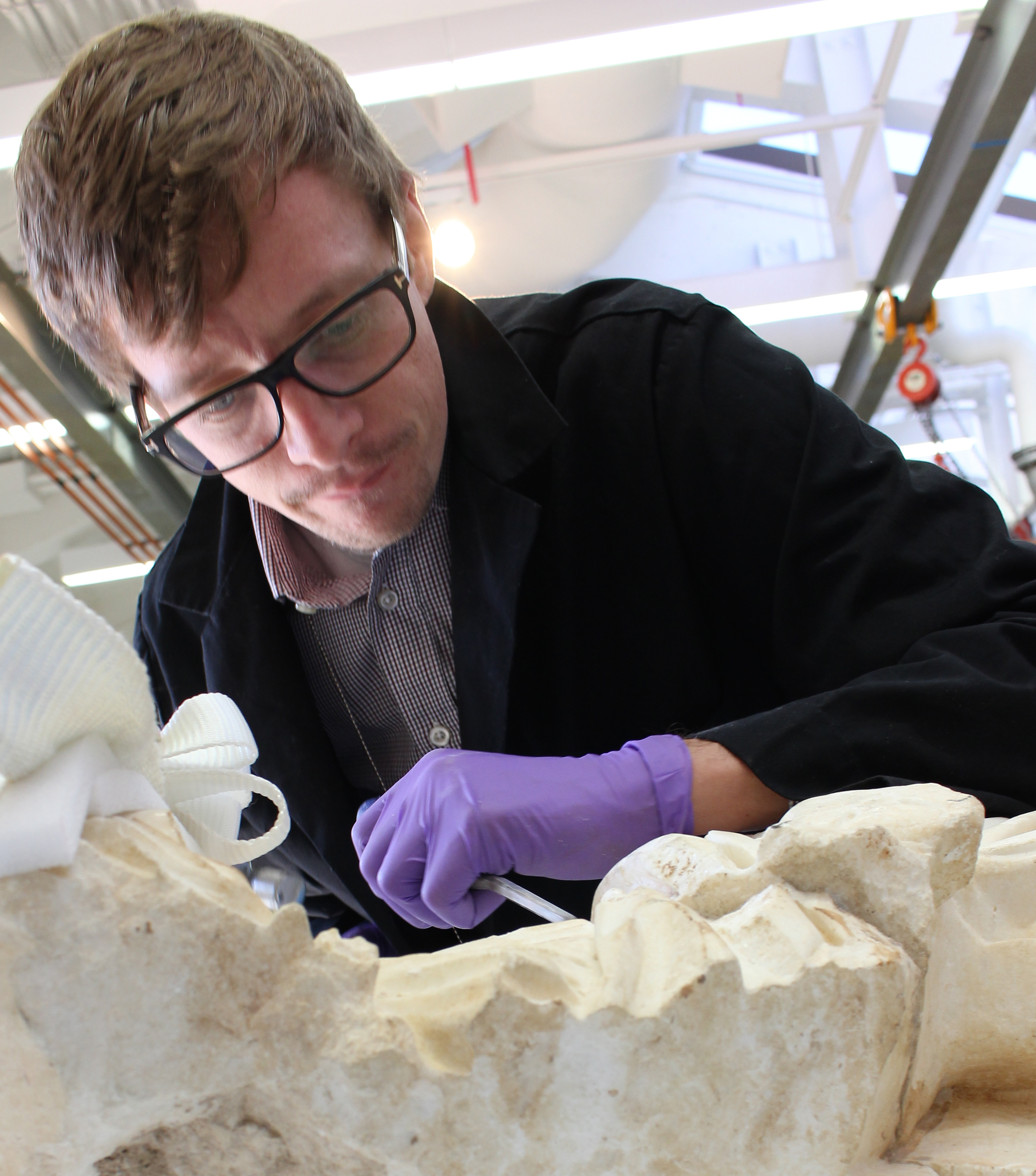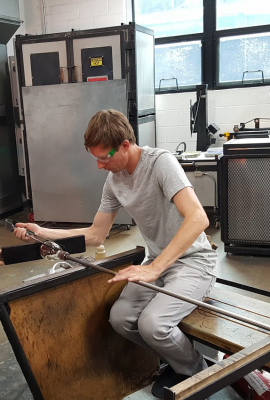Meet William Shelley, Laboratory Manager of the UCLA/Getty Conservation Program
 If you are a graduate student in the UCLA/Getty Conservation Program, you either know William Shelley or benefit from his work as Laboratory Manager of the program. Being a professional conservator and himself a 2016 graduate of the master’s program, Shelley is uniquely qualified to make sure the laboratories necessary for graduate students’ use are consistently supplied and technologically up-to-date. As Glenn Wharton, Chair of the Program puts it, “We were incredibly fortunate to hire William. Having gone through our program himself, he understands the student experience. This makes him highly effective in helping make our courses and the functioning of our research lab work well for both students and faculty.”
If you are a graduate student in the UCLA/Getty Conservation Program, you either know William Shelley or benefit from his work as Laboratory Manager of the program. Being a professional conservator and himself a 2016 graduate of the master’s program, Shelley is uniquely qualified to make sure the laboratories necessary for graduate students’ use are consistently supplied and technologically up-to-date. As Glenn Wharton, Chair of the Program puts it, “We were incredibly fortunate to hire William. Having gone through our program himself, he understands the student experience. This makes him highly effective in helping make our courses and the functioning of our research lab work well for both students and faculty.”
Working with both professors and students, he assures that there are sufficient supplies for academic requirements as well as for all the treatments involved. As an example, he explained that he often creates mock-ups on which students can practice conservation techniques so that “their first experience is not on an actual object” that is being studied. He also assists with x-radiography and working with the Getty antiquities department, and has been trained to do the x-radiography himself. He has developed a close relationship with the antiquities conservation department at the Getty, where he was an assistant conservator before coming to UCLA.
Shelley also describes himself as the “registrar" for the Conservation department, keeping track of the objects to be studied that come in from local institutions or museums and that must eventually be returned. “Somebody has to be responsible for arranging those loans and the paperwork required for each object,” he notes. It can be intimidating, he added, “especially when you have very small objects, to make sure that nothing unexpected happens. We also have a small study collection of our own objects,” he noted, “so the students and professors can use those objects without having to worry about asking permission from the lender. This is especially important when we want to practice taking a sample, test a new treatment, or use certain chemicals. With our own objects, students can go ahead and use those before they work on others” he added.
When objects are originally submitted for examination, “the initial agreement is that the objects will be housed at the Getty Villa,” Shelley explained. “Then our students will examine them and prepare treatment proposals.” The proposal usually would involve all the steps the students would like to carry out, such as cleaning, repair or a full scale reconstruction. Shelley can help by reviewing the proposals, which will then be sent to the lender who must sign off before the students can start to work. He gave an example of a ceramic pot that had been put together elsewhere, but the pieces were poorly adhered and were failing. So the students took it apart and put the pieces together more professionally.
 “Our lab is a little unique in that it is an off-campus lab, located within the Getty Conservation Institute (GCI) at the Getty Villa in Malibu,” Shelley noted. Because of that, his duties include making sure that members of the Conservation department “follow all of the health and safety requirements” of the Getty, as well as those of UCLA. The Conservation program also has a lab housed at the Cotsen Institute, which is primarily an analytical lab. Students using the labs include MA and PhD candidates.
“Our lab is a little unique in that it is an off-campus lab, located within the Getty Conservation Institute (GCI) at the Getty Villa in Malibu,” Shelley noted. Because of that, his duties include making sure that members of the Conservation department “follow all of the health and safety requirements” of the Getty, as well as those of UCLA. The Conservation program also has a lab housed at the Cotsen Institute, which is primarily an analytical lab. Students using the labs include MA and PhD candidates.
Shelley has an undergraduate degree in art history from the University of Miami, Florida, and a post-baccalaureate Certificate in Conservation from the Studio Arts Center International in Florence, Italy. He completed his third year graduate practicum internship in Kalamata, Greece, working at both the Laboratory of Archaeometry at the University of Peloponnese and the 38th Ephorate of Prehistoric and Classical Antiquities. He also held internships at the Toledo Museum of Art, the Maryland Archaeological Conservation Laboratory, the Anthropology Conservation Laboratory at the National Museum of Natural History, and the Western Archaeological and Conservation Center.
When looking for graduate programs, he wanted somewhere that included field work and education in three-dimensional objects. UCLA offered both, plus the opportunity to go abroad to work on excavations. As for the future of the program in which he is so deeply involved, he notes that he is working with program chair Glenn Wharton on incorporating sustainability “not only into our program, but into our lab.” He sees one of his main responsibilities as to “kind of green” the actual lab and make it more sustainable, as well as to help faculty with “practicals” within their syllabi.
In terms of the lab, this effort might include determining how to better recycle materials such as gloves, and to reuse them whenever possible. He explained that there are companies now that support recycling gloves. “That’s one physical thing we can do,” he noted. Another thing is to use chemicals that are less harmful to the environment, both in the production of the chemicals and in their use. “So the disposal is one thing, but creation is another.” He added that Wharton is bringing in a visiting researcher from Italy whose primary research will be on green chemicals in the field of conservation.
Shelley is the co-author of an article on the “Preliminary Research into Curricula in Sustainability for Cultural Heritage Conservation,” published by the American Institute for Conservation, as well as a paper on the work he did while at the Getty Villa on conservation and display of an Egyptian obelisk in Italy, “The Modern History of the Twin Obelisks of Benevento,” published in Aegyptiaca. Journal of the History of Reception of Ancient Egypt.
He has little free time between work and his family - currently including an 18-month-old daughter and the imminent arrival of a new baby. If he did, he might return to making glass in local studios. One of his other favorite things is visiting local botanical gardens, but at least this is something he can do with the entire family, no matter what size it is.
Published on May 4, 2023.


